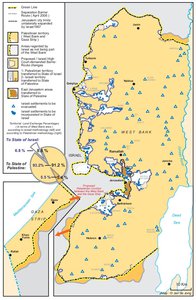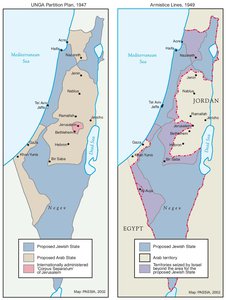THE UNGA PARTITION PLAN, 1947 – THE 1948 WAR & THE 1949 ARMISTICE LINES
Map Details
In early 1947, Britain announced its submission of the Palestine problem to the UN; its representative told the UNGA in May, “[w]e have tried for years to solve the problem... we now bring it to the United Nations in the hope that it can succeed where we have not.” At the same session, an 11-member Special Committee on Palestine (UNSCOP) was appointed to investigate the Palestine Question and prepare proposals for its solution. It was to be the 11th official committee of inquiry since 1919 and the 19th investigative body dispatched to the Mandate in 25 years. UNSCOP members arrived in Palestine in June 1947 and gathered information and testimonies until July, completing their report by late August. In September a so-called Ad-Hoc Committee was established to examine two proposals. The first plan called for the partition of Palestine into a Jewish and an Arab state, with Jerusalem and its environs under an international Corpus Separatum administration. This plan had the majority backing of the UNSCOP members, while a second plan, similar to the Morrison-Grady scheme (see Map 10), was supported by a minority. The Ad-Hoc Committee drew conflicting conclusions in its examination of the majority plan. In real terms, the proposal granted the Zionists a state in 56.47% of Palestine, leaving the Palestinians with 42.88% and creating an international zone of around 0.65%. In the proposed Jewish state the population was put at 905,000 - 498,000 Jews and 407,000 Palestinian Arabs. However, the Ad-Hoc Committee’s discovery of an ‘oversight’ with regard to the Bedouin population added 105,000 Arabs to the demography, placing the Jews in a minority and yet submitting over half a million indigenous Arabs to minority status. In the Arab state, only 10,000 Jews would remain among 725,000 Arabs, while in the Jerusalem zone there would be some 100,000 Jews and 105,000 Arabs (see Map 52). The plan gave the Zionists all or a part of 10 of the 16 sub-districts, in nine of which Jews were a minority. One report of the Ad-Hoc Committee noted that the proposal allotted the Beersheba district to the Jewish state, remarking “[i]t is surprising that the majority of an international committee such as [UNSCOP] should have recommended the transfer of a completely Arab territory and population to the control of the Jews, who form less than 1% of the population, against the wishes and interests of the Arabs, who form 99% of the population.” The majority (partition) proposal was nonetheless adopted by the UNGA on 29 November 1947, with Resolution 181. The injustice of partition has been summarized by Palestinian historian Walid Khalidi as follows: “They [the Palestinians] failed to see why it was not fair for the Jews to be a minority in a unitary Palestinian state, while it was fair for almost half of the Palestinian population - the indigenous majority on its ancestral soil - to be converted overnight into a minority under alien rule.” Every represented regional state voted against the plan, Britain abstained. Resolution 181 stipulated a two-month interim period following British withdrawal, wherein a UN Palestine Commission would transfer authority. This was never to happen. The day after UN Resolution 181 was passed, the Haganah called up all Jews between 17 and 25. The next week the assault on Jaffa (an Arab enclave in the partition plan) commenced. In the six months before Britain abandoned Palestine (14 May 1948), 380,000 Palestinians were forced from their homes, and at Deir Yassin (part of the proposed Corpus Separatum), the first of a series of massacres was perpetrated. British support, both in terms of training and equipment, for the powerful Zionist forces contrasted sharply with the absolute prevention of Palestinian militarization during the Mandate period. As a result, when war finally broke out there was only one army in Palestine and the indigenous population was left heavily dependent on regional intervention; this marked by ulterior and competing motives. When Britain quit the Mandate, Zionist forces were already in control of some 70% of Palestine. By the end of the war they would occupy nearly 78% of Palestine, incl. half of all the territory allotted the smaller Arab state in the partition plan. Transjordan would be in control of the remainder of eastern Palestine - the West Bank - and Egypt would control the Gaza Strip. By November 1948, the UNSC was able to initiate the process of demarcating a permanent armistice. Israel signed an agreement with Egypt in February 1949, with Lebanon in March, with Jordan in April and with Syria in July. The armistice agreements allowed for four demilitarized zones and four ‘no-man’s land’ areas (in Jerusalem and near Latrun Monastry). International efforts to build permanent peace treaties between Israel and the Arab states were short-lived and ended in failure. The April 1949 Lausanne Conference, where delegates from Israel, Jordan, Syria, Lebanon and the Arab Higher Committee met under the auspices of the UN’s Palestine Conciliation Commission (PCC), collapsed when Israel quit in mid-summer. Israel’s position was simple: Delegate Abba Eban wrote Ben-Gurion, “There’s no need to run after peace. The armistice is enough for us. If we pursue peace, the Arabs will demand a price of us - borders or refugees or both. Let us wait a few years.”
Related Maps
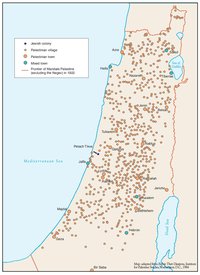
OTTOMAN PALESTINE, 1878
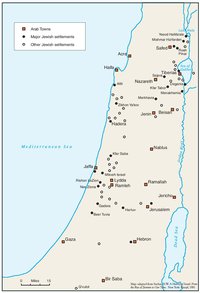
ARAB TOWNS AND JEWISH SETTLEMENTS IN PALESTINE, 1881-1914
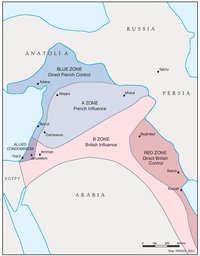
THE SYKES-PICOT AGREEMENT, 1916
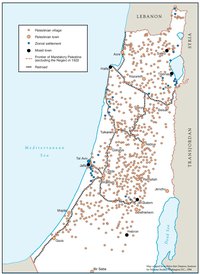
THE BEGINNING OF THE BRITISH MANDATE, 1920
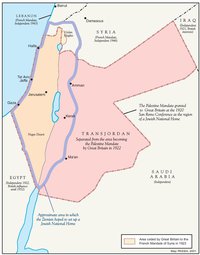
PALESTINE UNDER THE BRITISH MANDATE
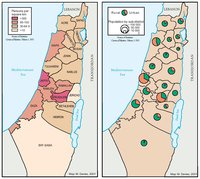
THE DEMOGRAPHY OF PALESTINE, 1931
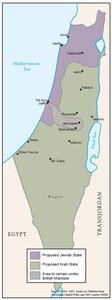
THE PEEL COMMISSION PARTITION PROPOSAL, 1937
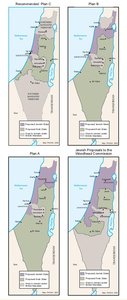
THE WOODHEAD COMMISSION PARTITION PROPOSALS, 1938
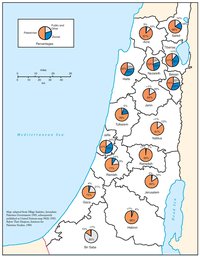
PALESTINIAN AND ZIONIST LANDOWNERSHIP BY SUB-DISTRICT, 1945
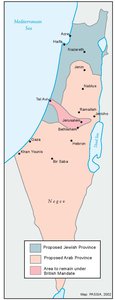
THE MORRISON-GRADY PARTITIONED TRUSTEESHIP PLAN, 1946
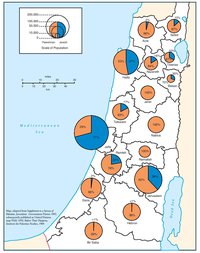
POPULATION OF PALESTINE BY SUB-DISTRICT, 1946
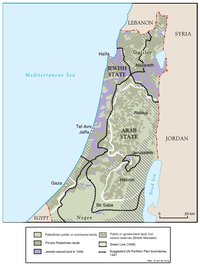
LAND OWNERSHIP IN PALESTINE, 1948
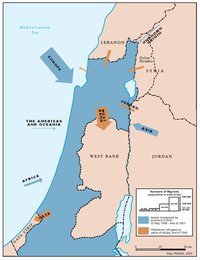
POPULATION MOVEMENTS, 1948-1951
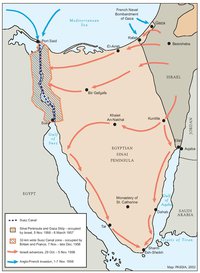
THE SUEZ WAR, 1956
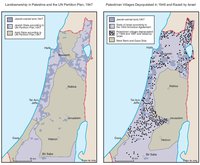
LAND OWNERSHIP IN PALESTINE AND THE UN PARTITION PLAN - PALESTINIAN DEPOPULATED AND DESTROYED VILLAGES, 1948-1949
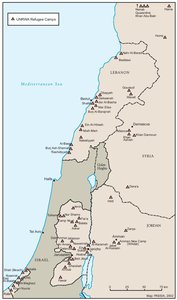
THE PALESTINIAN DIASPORA, 1958
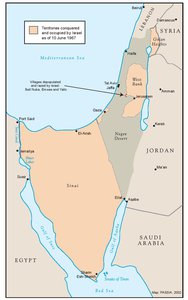
THE NEAR EAST AFTER THE JUNE 1967 WAR
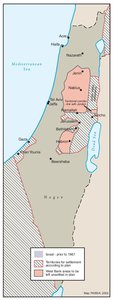
THE ALLON PLAN, JUNE 1967
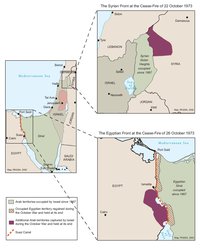
THE OCTOBER WAR, 1973
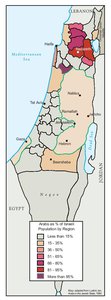
THE PALESTINIANS INSIDE ISRAEL, 1977
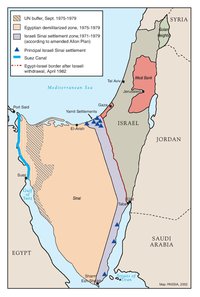
THE CAMP DAVID ACCORDS, 1978-1979
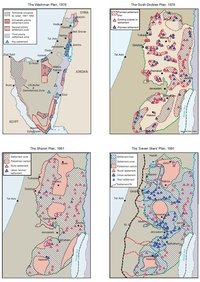
ISRAELI SETTLEMENT MASTER PLANS, 1976-1991
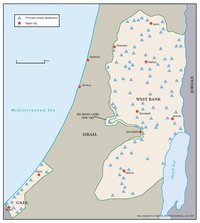
THE 1991 MADRID PEACE CONFERENCE & ISRAELI SETTLEMENTS
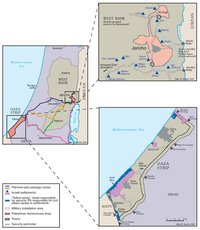
GAZA-JERICHO (OSLO I) AGREEMENT, CAIRO, 4 MAY 1994
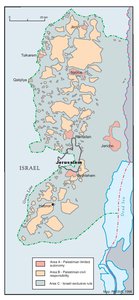
INTERIM (OSLO II) AGREEMENT, TABA, 28 SEPTEMBER 1995
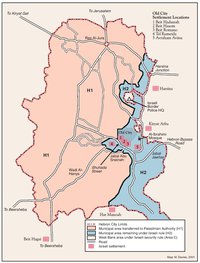
HEBRON PROTOCOL, 15 JANUARY 1997
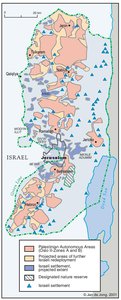
WYE RIVER MEMORANDUM, 23 OCTOBER 1998
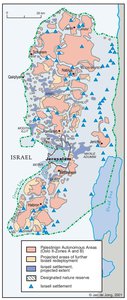
SHARM ESH-SHEIKH AGREEMENT, 4 SEPTEMBER 1999
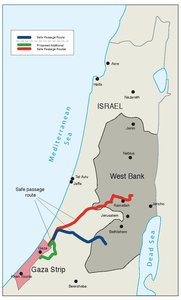
PROTOCOL CONCERNING SAFE PASSAGE BETWEEN THE WEST BANK AND THE GAZA STRIP, 5 OCTOBER 1999
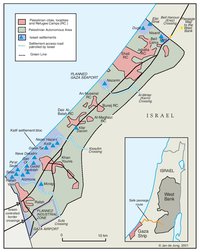
GAZA, 2000
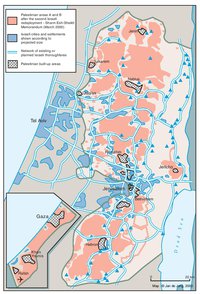
WEST BANK AND GAZA STRIP, MARCH 2000
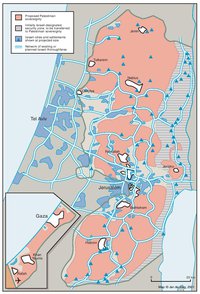
CAMP DAVID PROJECTION, JULY 2000
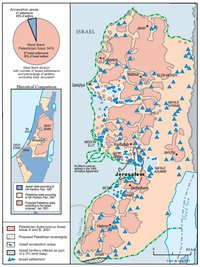
TABA TALKS PROJECTION, JANUARY 2001
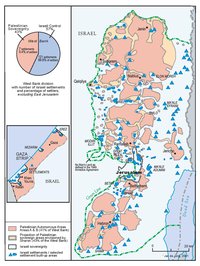
THE SHARON PROPOSAL, SPRING 2001
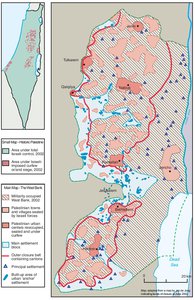
THE REINVASION OF THE PALESTINIAN TERRITORIES, 2001-2002
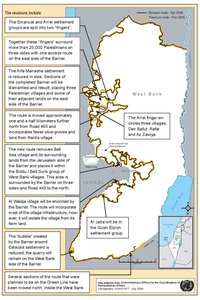
THE ROAD MAP, 2003
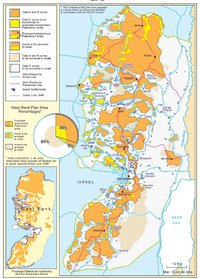
THE GENEVA INITIATIVE AND ACCORD, 2003
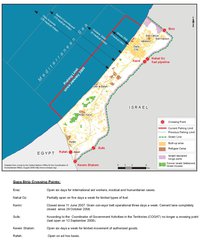
THE ISRAELI DISENGAGEMENT PLAN, 2003-2005
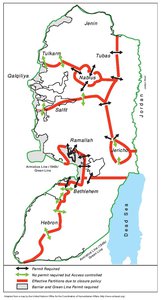
AGREED DOCUMENTS ON MOVEMENT AND ACCESS FROM AND TO GAZA, 2005
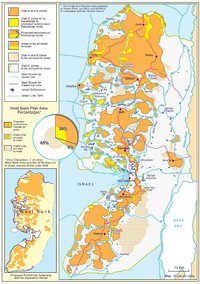
THE SETTLERS' PLAN FOR PALESTINIAN AUTONOMY, 2006
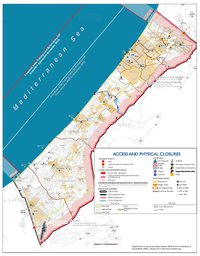
THE GAZA STRIP TODAY (2014)
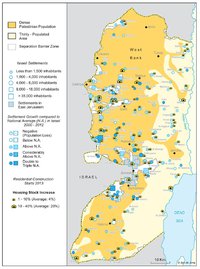
THE WEST BANK TODAY (2014)
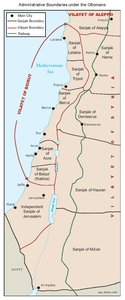
ADMINISTRATIVE BOUNDARIES
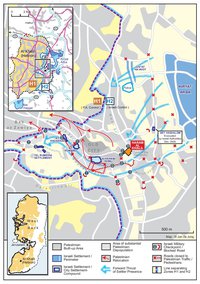
HEBRON
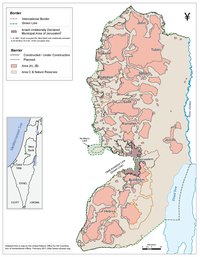
Area C
